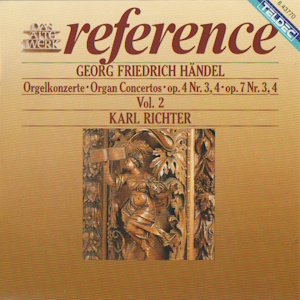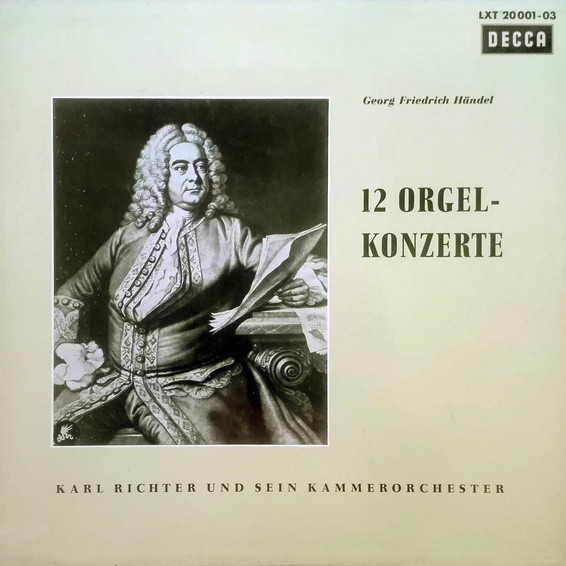 |
| 1 CD -
8.43770 ZS - (c) 1987 |
 |
3 LP -
LXT 20 001-03 - (p) 1959
|
|
ORGELKONZERTE - Vol. 2
|
|
|
|
|
|
|
|
|
|
| Georg Friedrich
HÄNDEL (1685-1759) |
Orgelkonzert
g-moll, Op. 4 Nr. 3 |
|
11' 35" |
|
|
|
- Adagio
|
4' 30" |
|
1 |
1-B1
|
|
- Allegro |
3' 56" |
|
2 |
1-B2
|
|
- Adagio |
1' 01" |
|
3 |
1-B3
|
|
-
Gavotte: Allegro
|
2' 08" |
|
4 |
1-B4
|
|
Orgelkonzert
B-dur, Op. 7 Nr. 3 |
|
13' 30" |
|
|
|
- Allegro |
4' 55" |
|
5 |
3-A1
|
|
- Organo ad
libitum (Adagio e Fuga) |
2' 31" |
|
6 |
3-A2
|
|
- Spiritoso |
4' 48" |
|
7 |
3-A3
|
|
-
Menuet
|
1' 16" |
|
8 |
3-A4 |
|
Orgelkonzert
F-dur, Op. 4 Nr. 4 |
|
15' 44" |
|
|
|
-
Allegro |
4' 19" |
|
9 |
1-B5 |
|
-
Andante |
6' 33" |
|
10 |
1-B6 |
|
- Adagio |
1' 19" |
|
11 |
1-B7 |
|
- Allegro |
3' 33" |
|
12 |
1-B8 |
|
Orgelkonzert
d-moll, Op. 7 Nr. 4 |
|
13' 38" |
|
|
|
- Adagio |
6' 11" |
|
13 |
3-A5 |
|
- Allegro |
4' 21" |
|
14 |
3-A6 |
|
- Organo ad
libitum
|
0' 59" |
|
15 |
3-A7 |
|
- Allegro |
2' 07" |
|
16 |
3-A8 |
|
|
|
|
|
Karl
RICHTER, Orgel
|
| und
sein Kammerorchester |
|
|
|
|
Luogo
e data di registrazione |
|
St.
Mark's Church, Munich (Germany) -
May & July 1958
|
|
|
Registrazione:
live / studio |
|
studio |
|
|
Producer |
|
-
|
|
|
Prima Edizione
LP |
|
Decca
- LXT 20 001-03 - (3 LP) - durata
2h 35' 25" - (p) 1959 - Analogico
|
|
|
Edizione
"Reference" CD
|
|
Tedec
- 8.43770 ZS - (1 CD) - LC 3706 -
durata 55' 07" - (c) 1987 - AAD |
|
|
Cover |
|
Detail
aus einem barocken Bilderrahmen
mit König David, Musen, Tugenden
und Lastem. Buchsbaumholz /
Holland gegen 1670, mit
freundlicher Genehmigung des
Museums für Kunst und Gewerbe,
Hamburg
|
|
|
Note |
|
The
Karl Richter edition of these
organ concertos by Handel
published in 1959 is here
reproduced on three compact discs
by TELDEC in the "reference"
series. Oddly enough, the first
volume (blue series) contains
Concertos Nos. 1 and 2 of Op. 4
and Op. 7; the second volume
(brown series) contains Concertos
Nos. 3 and 4 of Op. 4 and Op. 7;
the third volume (green series)
contains the Concerts Nos., 5 and
6 of Op, 4 and Op. 7. The multiple
editions published instead contain
the 6 Concertos of Op. 4 and to
follow the 6 Concertos of the Op.
7.
|
|
|
|
|
Georg
Friedrich Handel was the
cosmopolitan figure among
the great composers of
the high Baroque; he was
buried in Westminster
Abbey, London, like a
statesman. His father
came from an artisan
family, but had advanced
to become physician to
the nobility. He
earmarked his son Georg
Friedrich, born as the
ninth child on 24th
February 1685, for the
legal profession, but
the young Handel was
drawn to music early on.
The intervention of the
Duke of Weißenfels
enabled him to take
lessons in composition
and organ with Friedrich
Wilhelm Zachow in his
native Halle. In 1702 he
began to study law in
Halle in accordance with
paternal wishes, but he
paid less attention to
legal matters than to
his position as organist
and the
“Hautboisten-Companie”
in Halle, for whom he
probably composed parts
of the Trio Sonatas with
two oboes. The limited
possibilities of the
organist’s post were
soon inadequate for him,
and in 1703 he started
as a violinist in the
orchestra of Hamburg’s
Oper am Gansemarkt, the
forerunner of the
present Staatsoper. In
the space of two years
he had worked his way up
to the position of
harpsichordist, which
was the equivalent of a
modern conductor. From
1706 to 1710 he
travelled through Italy
in order to familiarize
himself with Italian
music. Almost the entire
spectrum of his works -
operas, oratorios,
orchestral and chamber
music - was influenced by
the impressions gathered
in these years, and
Handel was also
successful in Italy as a
composer in his own
right. He only needed
the initial stimulus to
make him go his own way,
full of ideas and
creative energy.
After a short visit to
London, he entered the
employment of the
Hanoverian court, and
when the Elector became
King George I of
England, Handel
travelled to London with
him. He remained
attached to the court,
but was attracted by the
public musical life of
the English capital. As
impresario, composer and
conductor “rolled into
one” he directed the
operatic venture known
as the Royal Academy of
Music; in 1728, however,
and again in 1734 his
theatre was forced to
close by pressure from
rival houses, and Handel
subsequently turned to
the dramatic oratorio.
The enterprising
publisher Walsh urged
him to supply him with
compositions, and in
1734 the Concerti grossi
op. 3 appeared - popular
works in the best sense
of the word, with
colourful
instrumentation such as
audiences were used to
hearing only at the
opera. The second set of
Concerti grossi op. 6
(1739) are also
important. Taking the
Corelli model as his
starting-point, Handel
treated the genre
freely, incorporating
dance movements and
episodes for a group of
soloists. Like the Trio
Sonatas op. 2 and op. 5,
they seem to be a glance
back from the artist’s
maturity at the years
spent in Italy. This is
pleasant music, but
without technical finesse
or harmonic subtleties.
In 1737 Handel composed
“Alexander’s Feast or
the Power of Music“ for
22nd November, the Feast
of St Cecilia, patron
saint of music. The
allegoric oratorio, in
which a singer subdues
the wrath of Alexander
the Great and awakens
human feelings with
music, is in the English
tradition of St Cecilia
works. Handel’s
oratorios, which he
performed at his own
risk with the help of
choirs composed of
London citizens, made
him the founder of the
oratorio choir
tradition. Between the
sections of the
oratorios he played his
organ concerti, in which
he improvised some
movements at the
keyboard.
Handel’s instrumental
works and oratorios are
among the most important
compositions of their
kind. TELDEC has helped
to evolve a new
understanding of
Handel’s music for years
with recordings that
lead the field, and the
unrivalled DAS ALTE WERK
catalogue reflects this.
Nikolaus Harnoncourt
Writes in his
stimulating book “Musik
als Klangrede”: “The
original sound only
interests me in that it
seems to me to be the
best of the many ways to
present one piece of
music or another today”.
Gerhard
Schuhmacher
Translation:
Clive R. Williams
|
|